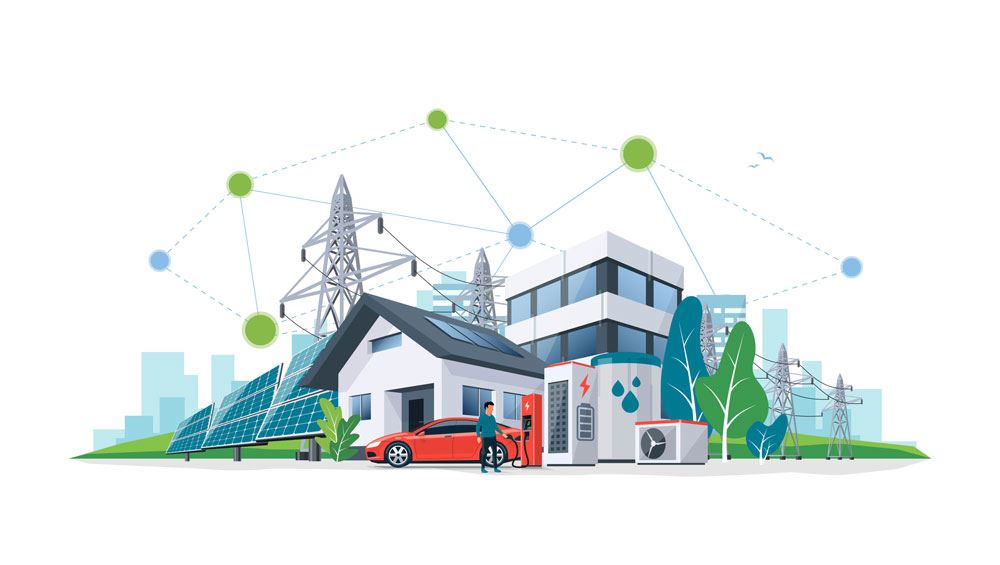FINE – Flexible Integration of Local Energy Communities
What interaction is necessary between DSOs and LECs?
Contact person

The project aimed to recommend interaction frameworks that efficiently integrate LECs in a grid-friendly manner.
DSO-LEC interaction
As local energy communities form across Europe, several potential challenges for distribution system operators arise. Because local energy communities introduce electricity generation and flexibility potential in the distribution grid, such as rooftop solar generation and charging of electric vehicles, DSOs aim to ensure that these resources are integrated in a manner that does not compromise security of supply. Yet, because these resources are not operated by the DSO but by the LEC, the DSOs benefit from creating incentives that align the cost-optimal operation of LECs with their own objectives. This is otherwise known as “incentive alignment.” However, this requires well-designed price signals, flexibility mechanisms and business models, that rely on tailored DSO-LEC interaction frameworks.
The LEC manager
The LEC manager is the connection point between the DSO and the LEC members. The LEC manager is responsible for ensuring that the objectives of the LEC members are pursued.
The LEC is a legal entity, meaning that LEC manager makes financial and legal decisions on behalf of the LEC members. The fact that the LEC is a legal entity is advantageous for the DSO, as the DSO can develop advanced, legally binding agreements with the LEC, which otherwise would be challenging with individual consumers that have more defined rights.
The LEC manager is an ideal agent to facilitate the interaction between the DSO and the LEC as the LEC manager’s role can be conducted by a professional third party. The LEC manager is responsible for interacting with the members and their assets or their commonly shared assets. This simplifies interaction with the DSO as the DSO decentralizes the responsibility of controlling the distributed energy resources. This is advantageous as innovative third parties may develop solutions for asset management inside the LEC.
Local coordination and the transfer of responsibility
In the FINE project, scenarios that describe potential pathways for DSOs and LECs have been introduced. In the cooperative scenario, the DSO retains their traditional approach by operating the grid traditionally, i.e., not conducting active measures in real time. However, the regulation is significantly modernized to allow for a more decentralized approach, allowing LECs to absorb some of the DSO's responsibilities. For example, the LEC may be given responsibility to maintain the voltage quality or to manage congestions in a specific grid area in exchange for the opportunity to operate distributed energy resources freely inside the LEC. An example of this approach is the introduction of LEC-level grid tariffs, where the LEC is metered on an aggregated level.
An alternative approach is a capacity contract, either through a non-firm connection agreement or by a dynamic grid tariff, where the LEC is free to operate normally whenever the grid is not congested. When the grid is congested, the DSO sends a signal to the LEC and requests the LEC to stay below the agreed capacity level, or in some cases, disconnects the LEC. This allows the DSO to provide LECs with opportunities in exchange for the transfer of responsibility for staying below the capacity level which is given to the LEC manager. This simplifies operation for the DSOs because they do not need to manage many assets and contracts but transfer some of those tasks to the LEC.
Efficient markets and the active DSO
The opposite to the local coordination scenario is the competitive scenario. Here, the interaction between the DSO and LEC is conducted through local flexibility markets (LFM), such as the market platform operated by NODES in Norway. Instead of forming contracts or agreements with the LECs, the DSO purchases flexibility through the LFM. The interaction between DSOs and LECs in this approach is through a market product. Both parties inform their preferences on price, flexibility volume, and location, which is then settled by the LFM operator. The LFM operator receives the bids, settles the markets, and conducts transactions, essentially being the intermediary between the DSO and the LEC manager.
If the market is efficient and has high liquidity, this solution is efficient, cheap and requires little communication. However, since LFMs are local, these market conditions cannot be guaranteed as there may be very few market participants available to solve specific grid challenges, such as congestions and voltage issues. Further, the DSO needs widespread measurements and operation software to act in these markets, requiring substantial interactions with the grid and with the LFM.
Different solutions for different challenges
LECs can be integrated efficiently into the Norwegian power system and distribution grid in a variety of ways. The different scenarios represent different solutions, which again require different DSO-LEC interaction schemes. In the FINE scenarios, this interaction spans from long-term contracts to “daily interaction”. There is no “one-size-fits-all”, and LECs represent a new paradigm in the power system with many new decentralized agents. If this value chain of consumers, LEC managers, LFM operators and DSOs has a weak point, the value chain stops functioning. A participatory scenario that represents a combination of the competitive and cooperative scenario may combine the most suited business models.
In the FINE project we have highlighted pathways for LEC integration in distribution grids, highlighting their advantages and drawbacks in economic, technical and regulatory terms. Long-term prospects and short-term measures are suggested and are further elaborated in the FINE final report .
